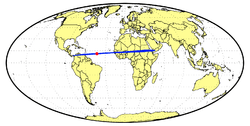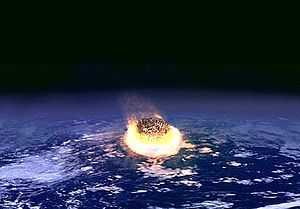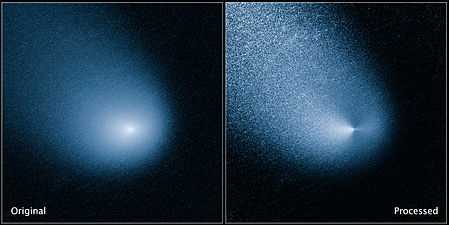2014 AA
|
Probable impact location of near-Earth asteroid 2014 AA based on infrasound data from the Comprehensive Nuclear-Test-Ban Treaty Organization.[1] | |
| Discovery[2] | |
|---|---|
| Discovered by |
Richard Kowalski Mount Lemmon Survey (G96) |
| Discovery date | 1 January 2014 |
| Designations | |
| MPC designation | 2014 AA |
| Apollo NEO[3] | |
| Orbital characteristics[3] | |
|
Epoch 2014-Jan-01 (Uncertainty=8)[3] | |
| Observation arc | ~70 minutes[2] |
| Aphelion | 1.41 AU (Q) |
| Perihelion | 0.91 AU (q) |
| 1.16 AU (a) | |
| Eccentricity | 0.21 |
| 1.3 yr | |
| 324° (M) | |
| Inclination | 1.4° |
| 102° | |
| 52° | |
| Physical characteristics | |
| Dimensions | ~3 meters (10 ft) |
| Mass | ~4×104 kg (assumed) |
| 30.9[3] | |
|
| |
2014 AA was a small near-Earth asteroid roughly 2–4 meters in diameter that struck Earth on 2 January 2014.[2] It was discovered on 1 January 2014 by Richard Kowalski at the Mount Lemmon Survey at an apparent magnitude of 19 using a 1.52-meter (60 in) reflecting telescope at Mount Lemmon Observatory.[2] 2014 AA was only observed over a short observation arc of about 70 minutes,[2] and entered Earth's atmosphere about 21 hours after discovery.[1]
Entry
Using a poorly determined orbit, the JPL Small-Body Database listed a 3-sigma solution with impact occurring around 2 January 2014 02:33 UT ± 1 hour and 5 minutes.[4] The Minor Planet Center listed impact as occurring around 2 January 2014 05:00 UT ± 10 hours.[2] Independent calculations by Bill Gray, the Minor Planet Center and Steve Chesley at the Jet Propulsion Laboratory have verified that impact was virtually certain.[2]
The impactor would have been roughly the size of 2008 TC3, which exploded above the Nubian Desert in Sudan on 7 October 2008. Calculations by Chesley suggest the impactor fell somewhere on an arc extending from Central America to East Africa, with a best-fit location just off the coast of West Africa.[2] Calculations by Pasquale Tricarico using the nominal orbit show that 2014 AA entered Earth's shadow cone approximately 40 minutes before entering the atmosphere.[5]
Infrasound was detected by three stations of the Comprehensive Nuclear-Test-Ban Treaty Organization.[6] Peter Brown and Petrus Jenniskens located weak signals from infrasound stations in Bolivia, Brazil and Bermuda.[1] 2014 AA entered Earth's atmosphere around 04:02 UT[1] 3,000 km from Caracas, Venezuela, far from any landmass.[6] No ships or planes have reported witnessing the event.[6]
Kowalski previously discovered 2008 TC3, the first asteroid discovered before Earth impact, using the same telescope in October 2008.[6] There are about a billion near-Earth objects in the size range of 2014 AA, and impacts of comparably-sized objects occur several times each year.[1]
References
- ↑ 1.0 1.1 1.2 1.3 1.4 "The First Discovered Asteroid of 2014 Collides With The Earth - An Update". NASA/JPL. 3 January 2014. Retrieved 4 January 2014.
- ↑ 2.0 2.1 2.2 2.3 2.4 2.5 2.6 2.7 "MPEC 2014-A02 : 2014 AA". IAU Minor Planet Center. 2 January 2014. Retrieved 2 January 2014. (K14A00A)
- ↑ 3.0 3.1 3.2 3.3 "JPL Small-Body Database Browser: (2014 AA)" (last observation: 1 January 2014; arc: 1 day). Jet Propulsion Laboratory. Retrieved 2 January 2014.
- ↑ "JPL Close-Approach Data: (2014 AA)" (last observation: 1 January 2014; arc: 1 day). Retrieved 2 January 2014.
- ↑ Guido, Ernesto (2 January 2014). "Small asteroid 2014 AA hit the Earth's atmosphere". Associazione Friulana di Astronomia e Meteorologia. Retrieved 2 January 2014.
- ↑ 6.0 6.1 6.2 6.3 Beatty, Kelly (2 January 2014). "Small Asteroid 2014 AA Hits Earth". Sky & Telescope. Retrieved 3 January 2014.
External links
- Orbital simulation from JPL (Java) / Ephemeris
- Two maps of the possible impact region (Yahoo groups / Project Pluto)
- 2014 AA – New Year’s Earth impactor (Carl W. Hergenrother)
- ScienceCasts: New Year's Asteroid Strike (ScienceAtNASA on YouTube)
| ||||||||||||||||||||||||||
| |||||||||||||||||||||||||||||||||||||||||




